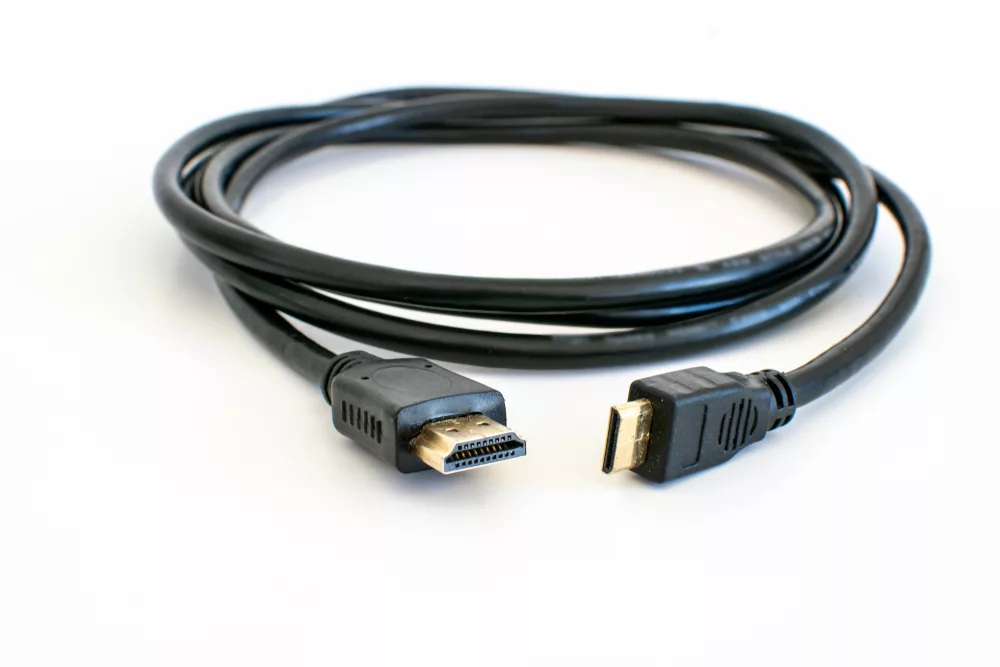About Active HDMI cable, Sometimes, the length of your HDMI cable is insufficient, and you need to look for solutions to extend the length. There are many ways to extend the HDMI cable length; however, active cables are the most common as it suits most applications.
The following blog post will discuss these active cables in detail.
Table of Contents

A standard HDMI cable
What are active HDMI cables?
The standard HDMI cables you use in most applications are passive.
These bi-directional cables can run in both directions, thicker for longer runs.
However, you may experience problems in high-resolution signals at longer runs without any extra processing ahead.
For example, for a 1080p signal, the maximum recommended length of an HDMI cable is 15 ft in 24 AWG.
On the other hand, active cables are specifically designed to meet long-distance requirements.
Unlike passive cables, these cables are directional, which means you need to connect one end to the source and the other to the display.
A label or mark on each active cable end lets you identify the source and display end.
The active HDMI cables have a fiber optic core or electronics processor, boosting the signal for long-distance transmission.
Types of active HDMI cables:
This part gives you a better understanding of active HDMI cables to make the right pick for your work.
Electronics active HDMI cables:
As the name clears, these active HDMI cables have special electronics that can boost/amplify the signal to travel to the display without degradation.
The processor of these cables helps in amplifying the signal.
These active HDMI cables need power for their functioning, and the cable dares the power either from the HDMI port of the display device or an additional power supply.
An active HDMI cable can go up to 50 feet or 15 meters.
You can find several options in electronics active HDMI cable; some have common features while others have some additional features. It mainly depends on the manufacturer.
As you read above, active HDMI cables have specific ends that cannot be reversed. Thus, checking the cable ends before installing them is essential, especially if they need to run into a wall.
Manufacturers advise that active cables should not run between two distribution devices or be used along with any extension.
Always use them directly from the source to the display device; if you use splitters or switches in any setup, it is advisable to use the active cable towards the output end of the distribution device.
Fiber optic active HDMI cables:
Also known as active optical cables or AOC, these cables have an optoelectronic module in their connector, which converts electrical signals into light or light into electrical signals. In other words, electrical signals are converted to photons using a combination of driver and laser. The other end of the cable receives these photons and converts them back into electrical impulses.
How are AOC powered?
The HDMI ports’ 5-volt output gives the cables the required power.
Also, you must know that while the data transfers through glass in these cables, they still have copper conductors.
Like other active cables, these are directional because the signal converts at its two ends.
Thus, you must ensure installation is done as per the markings on the connector heads.
Active optical cables are of various types and not only HDMI. You can find DisplayPort AOC, USB AOC, HDMI AOC, and many other types of AOC in the market these days.
One of the first AOCs was in data centers equipped with QSFP/SFP components, and the earliest AOC for the consumer market was LUxtera DisplayPort AOC.
As an active optical cable sends its data through optical fibers, it has higher bandwidth and long-distance capacity than standard cables.
A fiber optic active HDMI cable can extend the length up to a distance of 300 ft or 90 meters, but these cables will cost you much more than other active cables.
Some benefits of the fiber optic active HDMI cables:
- Require fewer materials during installations
- Highly resistant to electromagnetic interference
- Offers low latency
- Reduced lag as signals travel at the speed of light
Conclusion:
It’s great to have so many cables to choose from, but sometimes, it may also become confusing as customers wonder if they pick the suitable cable.
If you want any HDMI cable, Cloom Tec offers a wide range of cable assemblies that cater to your varying needs.
